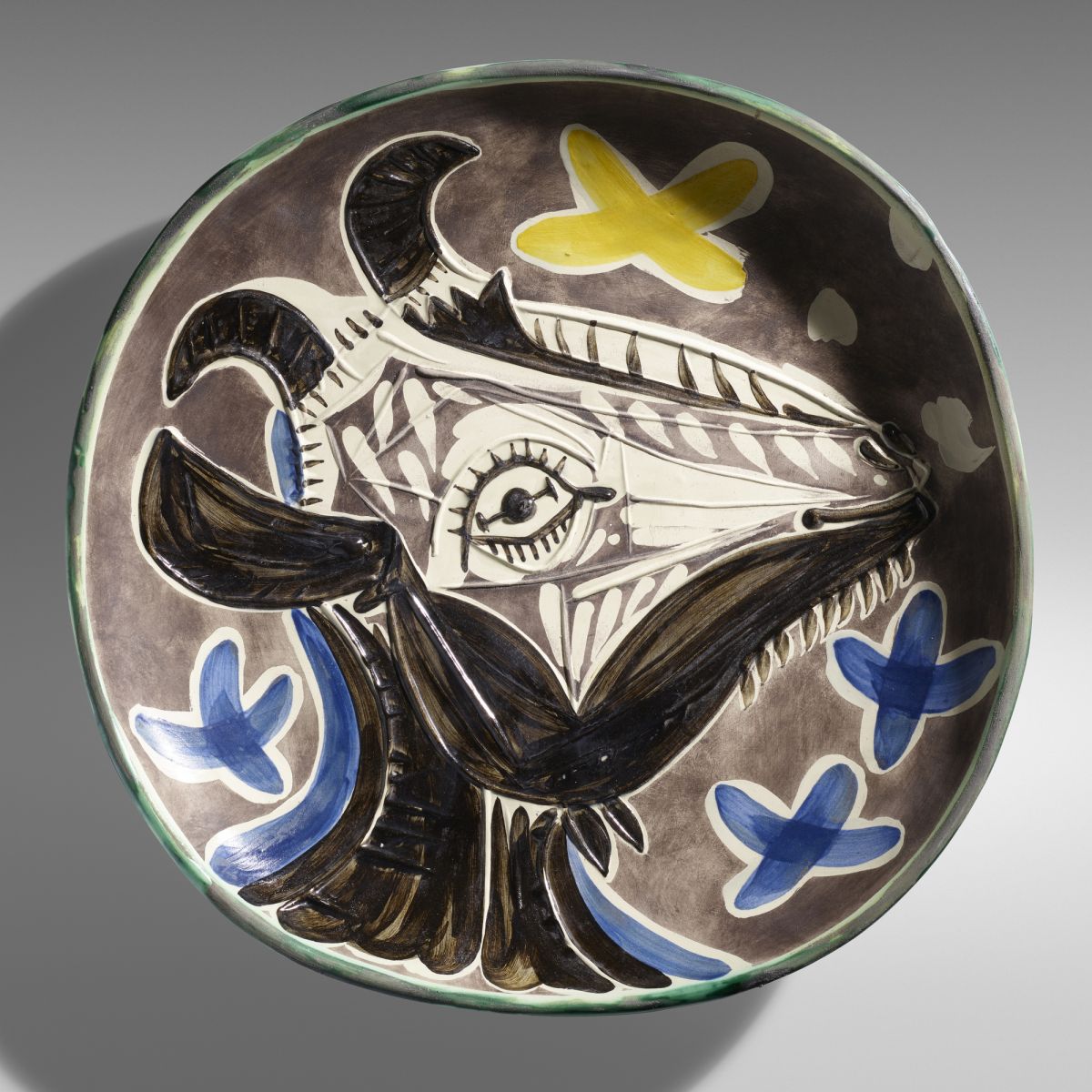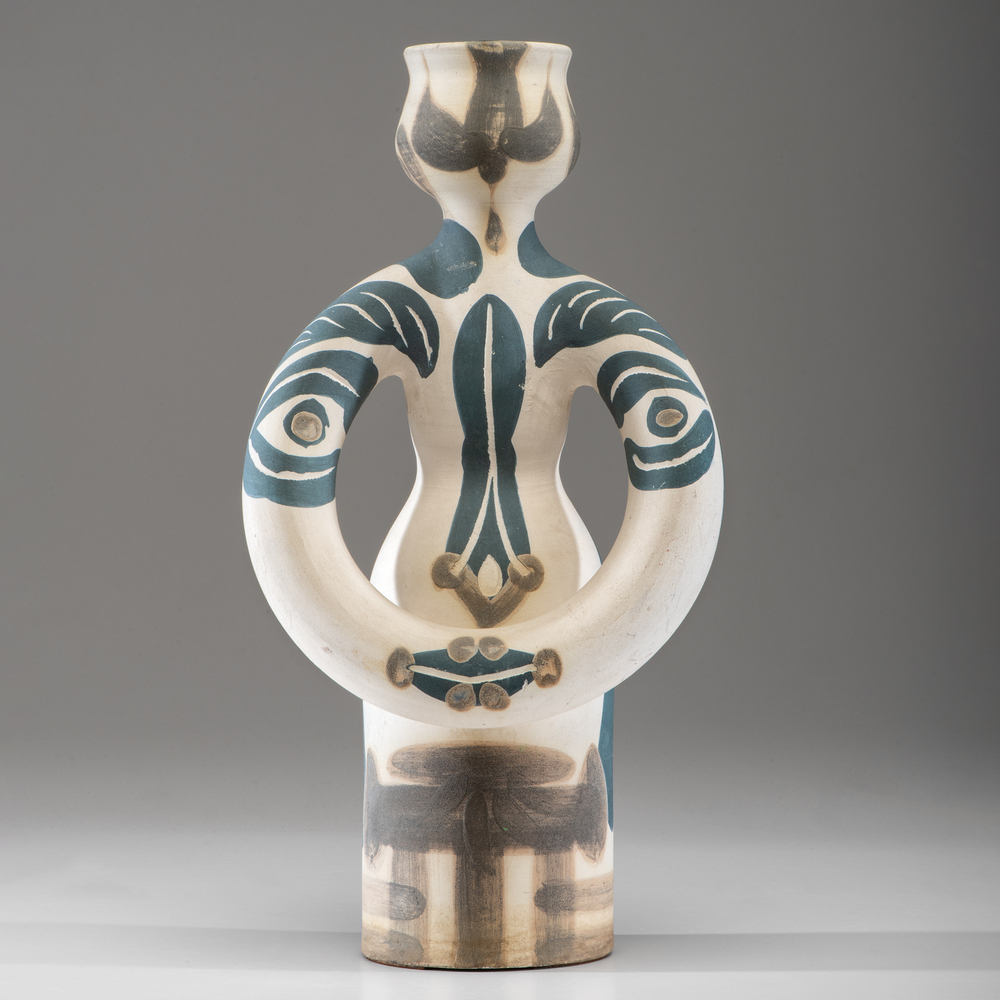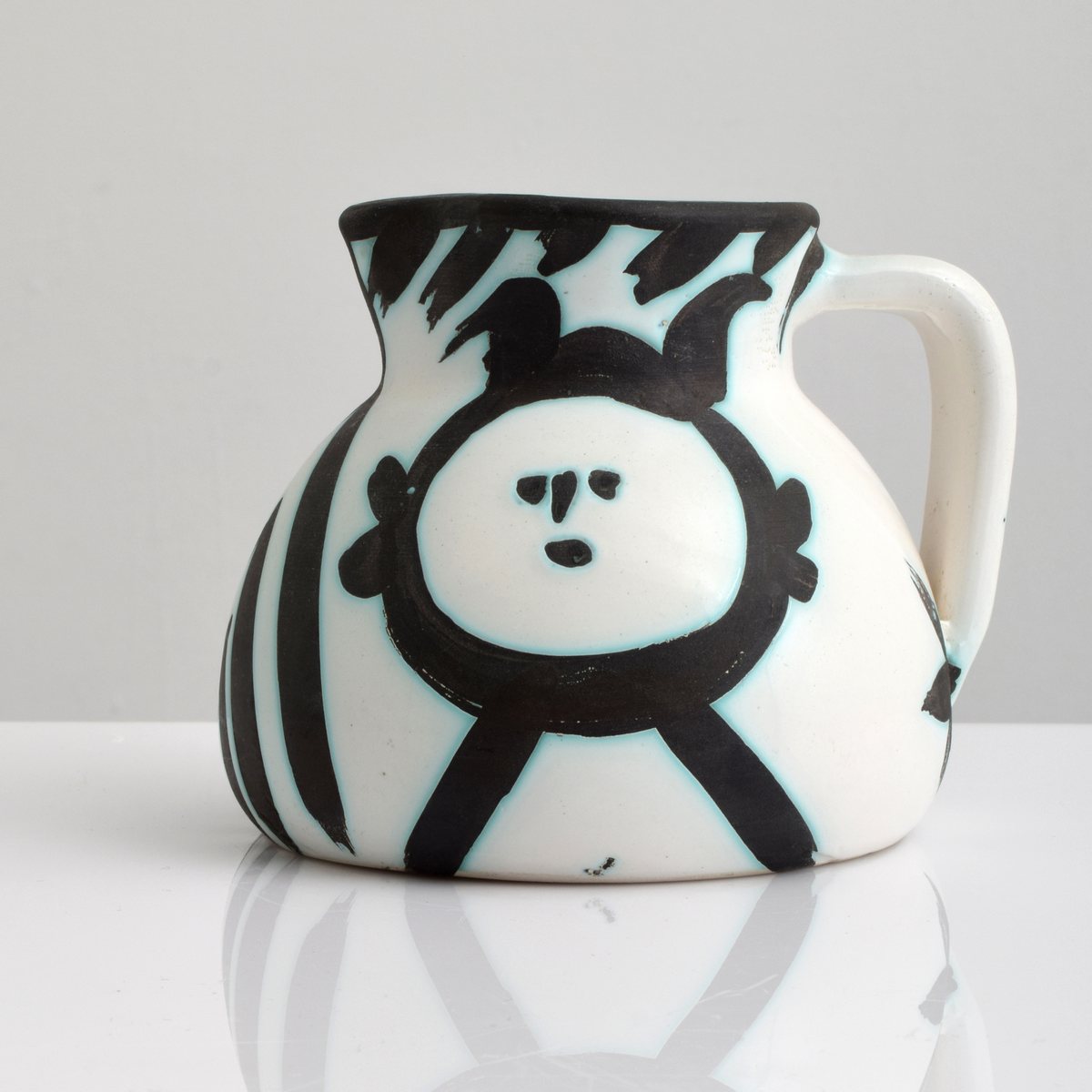Picasso Ceramics: A History and Collectors Guide
The uninterrupted desire to experiment was, perhaps, Pablo Picasso’s greatest attribute. A changemaker de facto - before his sixtieth birthday, the artist had already secured his name in history as a revolutionary force. Having evolved through several periods of art, beginning with the co-founding of Cubism and onward through tireless decades of dimensional shifts on canvas, Picasso delivered unrivaled modernity through iconic strokes of monumental proportion. Unsurprisingly, his later years were no different, and based on the over 3,500 fired clay works he would create from 1946-1973, he was just getting started.
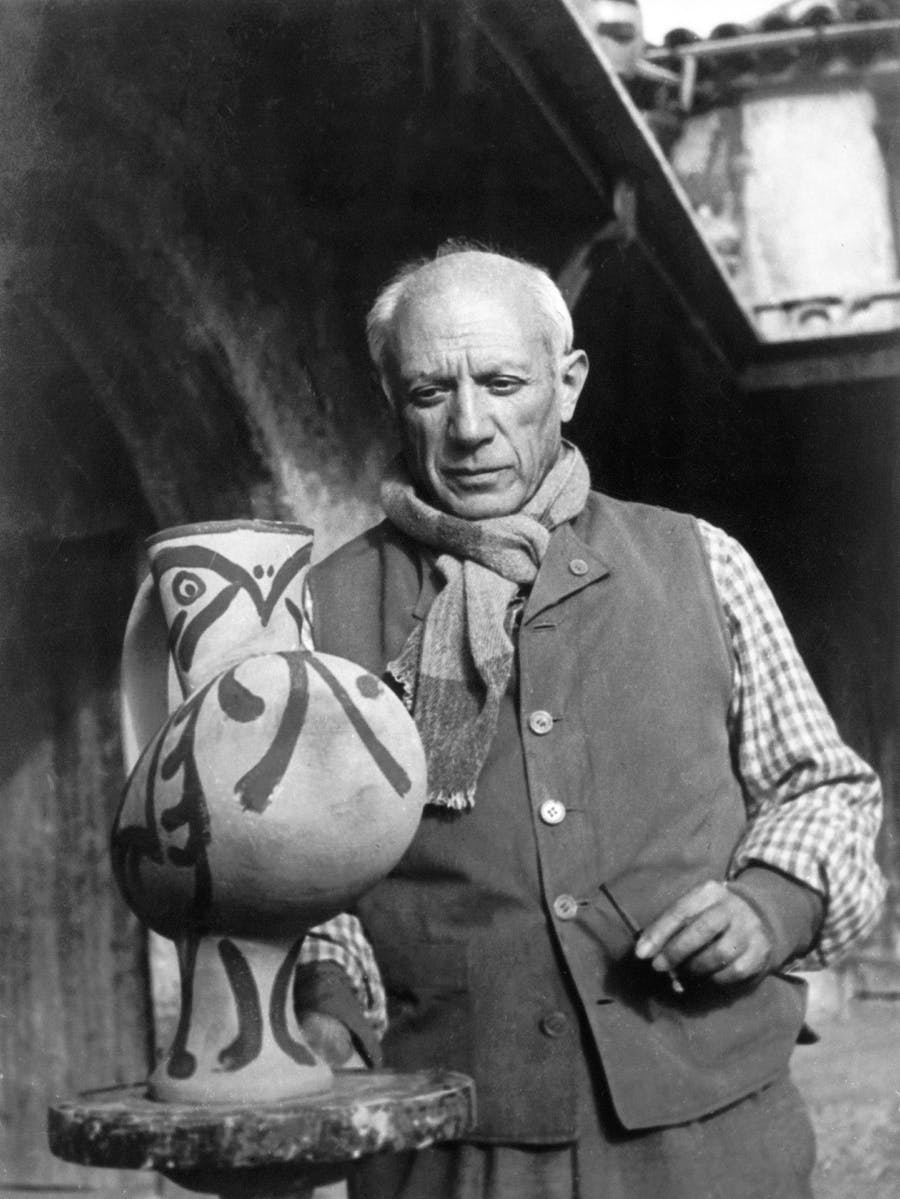
Picasso painting a piece of his pottery in his Vallauris studio. (Photo by Keystone-France/Gamma-Keystone via Getty Images)
FINDING CLAY
In 1946, while visiting the small coastal town of Vallauris in the south of France, Pablo Picasso would meet Georges and Suzanne Ramié of Madoura pottery during an annual clay exhibition. Inspired by the couple’s work and eager to experiment with the medium, the Ramiés agreed to open their workshop to Picasso, allowing him use of their tools and equipment - a collaboration which would flourish for the next 25 years, ending in 1971, only a few years before Picasso’s death in 1973.
A PICASSO FOR ALL
Venturing into clay revealed a fresh world of invention for Picasso. By combining his fearless use of line, color, texture and dimension into one process, his passion both accelerated and allowed him to democratize. Intent on making his artwork accessible to the public and persons who could not afford to purchase his already astronomically priced paintings, each piece Picasso created was done in editions of 500 and made available to purchase directly from the Madoura workshop. Utilitarian in form and classic in functionality, many of Picasso’s earlier designs were scratched and scored onto basic shapes such as platters and plates. However, as time went on, the artist progressed into exploratory forms and sculptural concepts.
Pablo Picasso, Tete de Chevre en Profil plate, Madoura Pottery, Spain / France, 1952. White earthenware clay decorated in engobes and brushed glazed, patinated ground, 16.25 dia in (41 cm) Impressed manufacturer's mark to verso 'Empreinte Originale de Picasso Madoura Plein Feu'. This work is from the edition of 100.
Picasso tested a number of production techniques but eventually landed on two main methods. First, he painstakingly reproduced each edition by hand, following the form and application of the original as closely as possible. The second method was to carve original images into clay molds to more easily and accurately transfer his designs onto fresh clay - works made using this method carry the mark Empreinte originale de Picasso. A total of 633 different ceramic editions were created from 1947-1971, with many variations and unique pieces born from the initial assembly.
A PANORAMA OF IDEAS
Much like his drawings and paintings, Picasso’s exacting marks found even deeper resonance in clay. Having long established his modern mastery over primitive art - whereby the aesthetic of his work was identifiable to no specific geographical location or time period but his own hand - the ancient spirit of the Mediterranean region naturally played a stylistic role. Bolstered by his location in the south of France and the longstanding history of the civilizations which once dominated the region; Romans, Eutruscans, Greeks, Iberians - the subject matters and glaze applications that struck Picasso began to take shape.
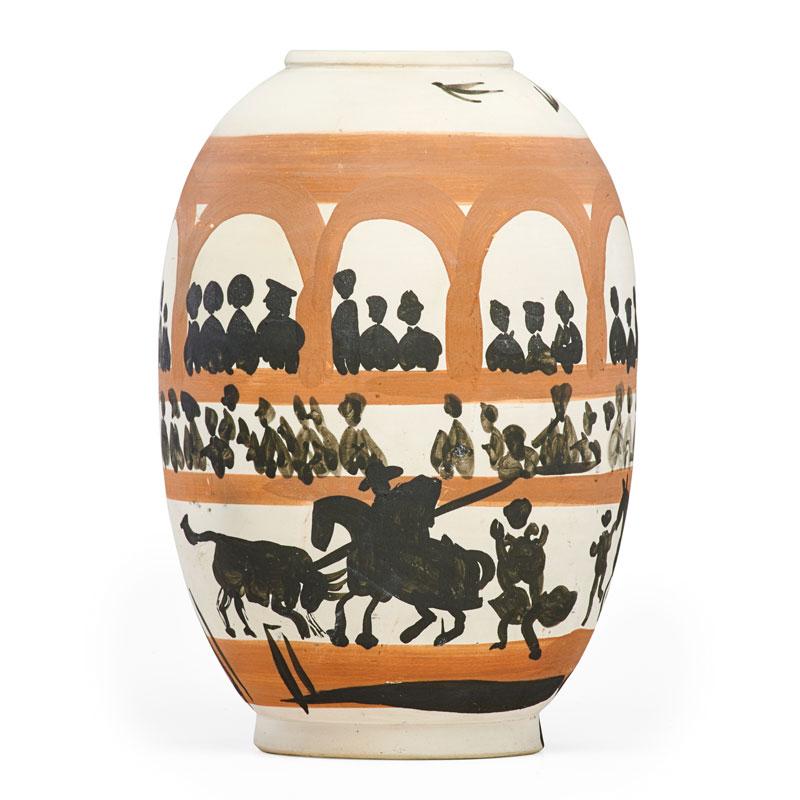
Pablo Picasso, Madoura, Glazed earthenware vase decorated in engobe, "Arena (Arène)," France, des. 1958. Impressed MADOURA PLEIN FEU EDITION PICASSO, numbered 41/100 and signed EDITION PICASSO in ink.
Collectors of Picasso ceramics can adopt a series of expressive animals ranging from fish, birds, owls, and goats, or venture into narrative scenes of bullfights, still lives, chariot riders and horsemen. It was also at Madoura where Picasso met his second wife and muse, Jacqueline Roque, whose portrait is affectionately repeated and reimagined the world over.
Pablo Picasso (Spanish, 1881-1973) Lampe Femme, 1955, earthenware, stamped Madoura Plein Feu and Edition Picasso on underside, inscribed Edition Picasso and numbered 180/200 on underside.
MOLDING THE MARKET
Picasso’s vision of expanding his collector base and maintaining lower price ranges through his editioned works did not last long. The magnetic quality of the artists ingenuity and wide variety in the medium has created a robust auction market - Le Hibou (Rouge et Blanc) (1953), a one-of-a-kind earthenware sculpture of a spotted owl, set the auction record for Picasso’s ceramics, selling for $2.4 million at Christie’s in 2016. Interest in Picasso ceramics has continued to grow as they are regularly purchased and exhibited by museums and bought as significant investments in decorum. The guidelines for collectors mainly rest in their stylistic affections. The most enjoyable aspect of collecting Picasso ceramics is appreciating the artist's playful tone - with a flick of the wrist, loose dots translate into feathers and repeating lines into wide, all-knowing eyes.
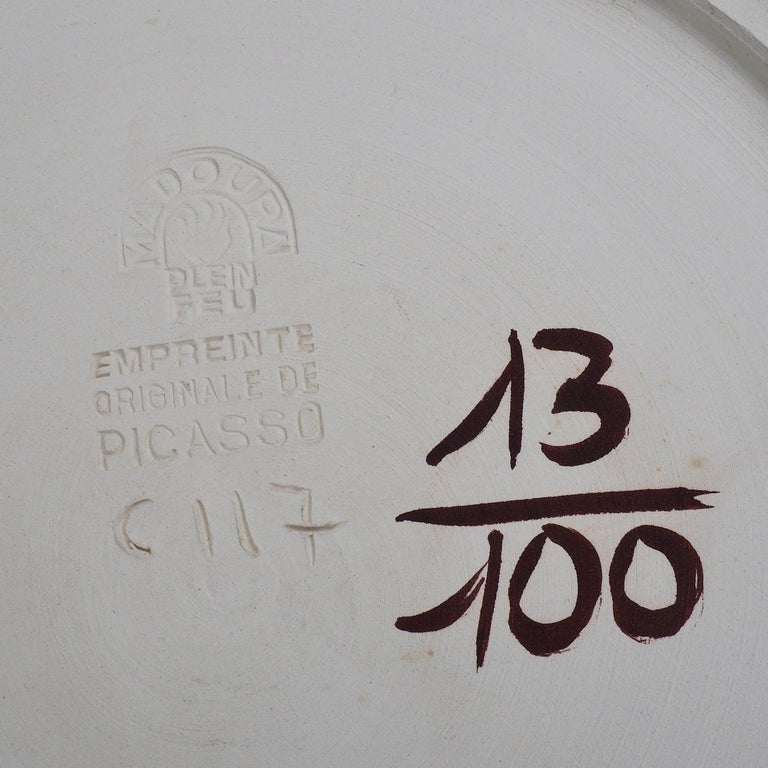
Markings on the back of a large ceramic plate. Stamped to base: C117 Madoura Plein Feu, Empreinte Originale de Picasso and numbered in fired slip 13/100.
Regularly selling for tens of thousands, it’s important that investors consider the condition of the piece as many originals either had imperfections from the original firing or have been chipped and repaired over the years. In addition, each ceramic produced by Picasso features a stamp or marking, which can be found on the underside, reverse, or even the inside of the form. Some editions include their ‘edition number’ (e.g. 1/40) or a date. Following the instructions of Picasso's will, some of his ceramic pieces were reissued, ranging from 25 to 500 copies per series. Picasso chose these particular works with the help of the Ramiés, and entrusted the exclusive distribution of the works to the Madoura workshop. These stamps and markings differ from one edition to another, and were used in different periods of time. The most common to look for, however, are ‘Madoura Plein Feu’, ‘Empreinte Originale de Picasso’ and ‘Edition Picasso’.
Pablo Picasso (Spanish, 1881-1973); Madoura, Madoura Plein Feu imprint, Edition Picasso imprint, Edition Picasso; 1953. Sold for $4,688 in Palm Beach Modern Auctions 2021 sale.
A PIECE OF YOUR OWN
Finding an affordable work of Picasso ceramics in today’s market can be a challenge but it’s not unheard of to stay below $5,000 for a perfectly wonderful piece. Depending on the edition, date and the rarity of the form, recent auctions have cataloged starting bids as low as $750-$1000, a reasonable entry price considering their ever expanding popularity. A convenient feature on Bidsquare, which can also help you keep track of upcoming opportunities, is the ‘Saved Search Alert’ section found in the ‘My Alert’ tab of one's personal account profile. There, you can input the keyword, ‘Picasso Ceramic’ to receive notifications every time one pops up on the platform.
____________________________________
Watch Pablo Picasso at work in his studio in Vallaruis, including footage of him carving into and painting on his ceramics in the documnetary film from 1954, Directed by Luciano Emmer and music by Roman Vlad:
Don't have a Bidsquare account? Sign up here!
Be in the know about upcoming auctions and exciting post-sale results by following us on Facebook and Instagram.
_______________________________
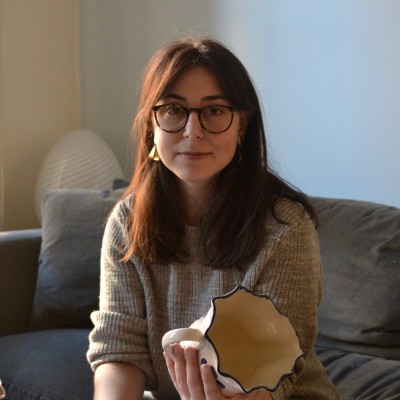
Jessica Helen Weinberg | Senior Content Editor at Bidsquare
- Artist Spotlight: David Gerstein, Sculptural Pop in Bold Color & Motion
- The History of Rolex Watches: Innovation, Precision, and Enduring Prestige
- Preview the December Doyle+Design Auction: A Celebration of Modern & Contemporary Mastery
- Billings Winter Design 2025: A Celebration of Modern Mastery Across Eras
- The Ultimate Holiday Gift Guide: Luxe Finds From Bidsquare’s Finest Auctions
- Fine & Antique Jewelry Sale: A Curated Journey Through Craftsmanship & Design
- Upcoming Auction Spotlight: Doyle’s Fine Art: 19th Century & Early Modernism
- Entertain with Style This Holiday Season: Highlights from Doyle’s December 8 Auction
- Six Standout Lots from Newel’s Fine Jewelry, Timepieces & Luxury Handbags Sale
- Artist Spotlight: Roy Lichtenstein, Pop Art’s Master of Bold Lines & Bigger Ideas



 EUR
EUR CAD
CAD AUD
AUD GBP
GBP MXN
MXN HKD
HKD CNY
CNY MYR
MYR SEK
SEK SGD
SGD CHF
CHF THB
THB